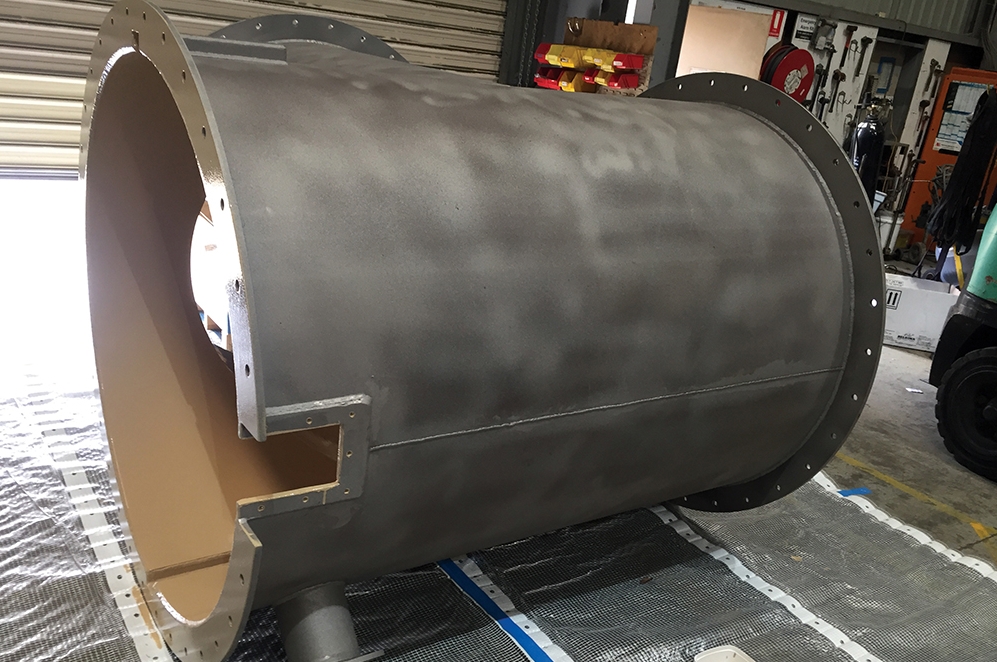Pumps are at the heart of any fluid handling system and notably are the second most common piece of machinery used in general industry. Coupled with a heavy reliance on pumps and the detrimental effects of erosion-corrosion, pump efficiency can deteriorate significantly over years in service, simultaneously resulting in increased energy costs. In-service deterioration cannot be negated completely, in fact, designing a pump that is totally immune to these effects is virtually impossible. However, through the use of protective polymeric coatings, which provide an additional barrier against the effects of corrosion, erosion and cavitation, pumps can significantly exceed their original expected design life.
In some instances, the lifespan of pumps that have been coated using polymeric systems have been dramatically extended. Notably, cooling water pumps at Vales Point Power Station in New South Wales, Australia, are still functioning efficiently after being initially repaired and coated using polymeric systems back in 1980, spanning an in-service period of 37 years.
Exposing the galvanic nightmare
Towards the end of 1978, the opportunity was taken to examine two main cooling water pumps, following a turbine seizure, with inspection revealing a vast amount of damage. Together, the high velocity salt water, alongside prolonged immersion in a solution featuring hydrogen sulphide, methane and considerable decaying marine life, had created a severely corrosive environment.
In addition, the pump’s composition included an assortment of stainless steel castings, austenitic cast iron, standard grey cast iron, with just a touch of phosphor bronze. Fundamentally, this contributed to a galvanic corrosion nightmare. Furthermore, some of the marine growth, including crustaceans, had incredibly penetrated up to 0.5 inches (12.7mm) into the cast iron. At this stage, temporary repairs were made by fitting false flanges and using a tar epoxy coating. The pumps were put back into service and the power station made immediate enquiries into replacement components.
 Polymeric solution offers viable alternative
Polymeric solution offers viable alternative
Amid enquiries at the beginning of 1980, Senior Maintenance Engineers from the power plant consulted Belzona’s Australian Distributor, Rezitech, to discuss the repair and protection of the cooling water pumps with polymeric solutions. Existing pump applications using polymeric materials highlighted answers for identical problems that the Engineers were investigating. Therefore, interest culminated in a request to inspect the pumps and advise on the possibility of repairs. Shortly after, partial restoration of one of the main cooling water pumps began, with the work being completed in 12 days and the pump returned to service. Impressed with the visual results, it was decided to carry out a full reclamation on the next pump.
Each pump measured a total of 52ft (15.8m) in height, dictating that the repairs were completed in a quarry off-site; in part, due to local regulations restricting grit-blasting in an industrial area. Following the appropriate surface preparation, the extent of the metal loss was revealed to be extreme, particularly due to vastly graphitised areas deteriorating the metal work further. Using a ceramic-filled epoxy-based repair composite, efforts began in earnest to rebuild the various pump components, including the suction bell, diffuser, impeller and drive shaft. Due to the ceramic composition of the repair material, it offered significant erosion-corrosion protection, versus welding new metal into place. In addition, the cold-applied systems ensured the elimination of hot work, which could potentially cause further weaknesses in the already vulnerable metal and prolong the threat of galvanic corrosion.
In addition, this material was ideally suited to be over coated with a ceramic-filled coating to ensure long-lasting performance in the face of erosion-corrosion and chemical attack. Applicators ensured maximum protection by coating each component internally and externally, providing the pumps with a further barrier against aggressive marine growth. The pumps were inspected every month thereafter and seventeen months later, a diver’s report indicated that the pumps were still in perfect condition.
Maintenance remains the key to longevity
Since then these pumps have been maintained on a regular basis using Belzona systems. Over time, product selection has since changed, with the original materials being replaced by an internal coating of Belzona 1321 (Ceramic S-Metal) and external protection achieved using Belzona 1341 (Supermetalglide). There can be no doubt that if it were not for polymeric materials, these pumps would be out of commission and, in all probability, scrapped eventually, well within their projected life. The full lifespan of the pumps was estimated at ten years and this has been exceeded dramatically without the need to replace, highlighting the longevity which polymeric coatings can provide.



